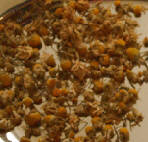Camomile (or chamomile) takes its name from the Greek words for “ground” and “apple,” because it grows close to the ground and its strong aroma is reminiscent of apples. It is one of the most loved teas in Greece and is regularly gathered in the wild, washed thoroughly, and laid out to dry at home.

Dried camomile (chamomile)
Greek name and pronunciation:
χαμομήλι, pronounced hah-mo-MEE-lee
At the market:
Camomile is sold in individual tea bags, tea pouches for larger size teapots, and in containers of dried leaves and flowers. Better quality camomile products will contain leaves, flowers, and a few stems.
Physical characteristics:
Dried leaves are narrow and spear-shaped, 1/2-inch to 1-inch long and light tan to pale green. Flowers are 1/4-inch diameter yellow-orange bulbs. Stems are 1/16-inch diameter and shades of brown. In the wild, fields of camomile look like a light dusting of snow.
Making Camomile Tea:
Using the dried flowers and leaves, the basic “recipe” for camomile is 1 rounded teaspoon of dried flowers boiled in water and strained for each cup of tea. Honey is a favorite sweetener, and it also tastes delightful with a squeeze of lemon or lime. (A sprinkle of cinnamon adds an interesting taste.)
Therapeutic Effects:
In Greece, camomile is enjoyed for its wonderful taste, but it is also attributed with medicinal properties that have come down through the centuries (see history, below). It is thought that camomile relieves upset stomachs and indigestion, calms and relaxes, and promotes sleep.
Origin, History, and Mythology:
Botanists classify camomile as two major varieties: Anthemis nobilis, the Roman variety, andMatricaria recutita, the German variety. Both grow wild in most temperate climates. Camomile re-seeds itself and is considered an annual and a perennial – depending on which expert you ask.The ancient Egyptians believed camomile to be a sacred herb and associated its use with their sun god Ra.Camomile has been used since ancient times for a variety of medicinal and therapeutic purposes. Dioscorides – a Greek physician, pharmacologist, and botanist with Roman Emperor Nero’s army – prescribed camomile for several gastrointestinal disorders, nervous conditions, and liver disorders. Other medicinal uses for camomile preparations were to treat women’s ailments and kidney stones.
Experienced gardeners think of camomile as a “Plant Doctor” herb because it has a remedial and healthy effect on neighboring plants – especially plants which appear weak or “sick.”
